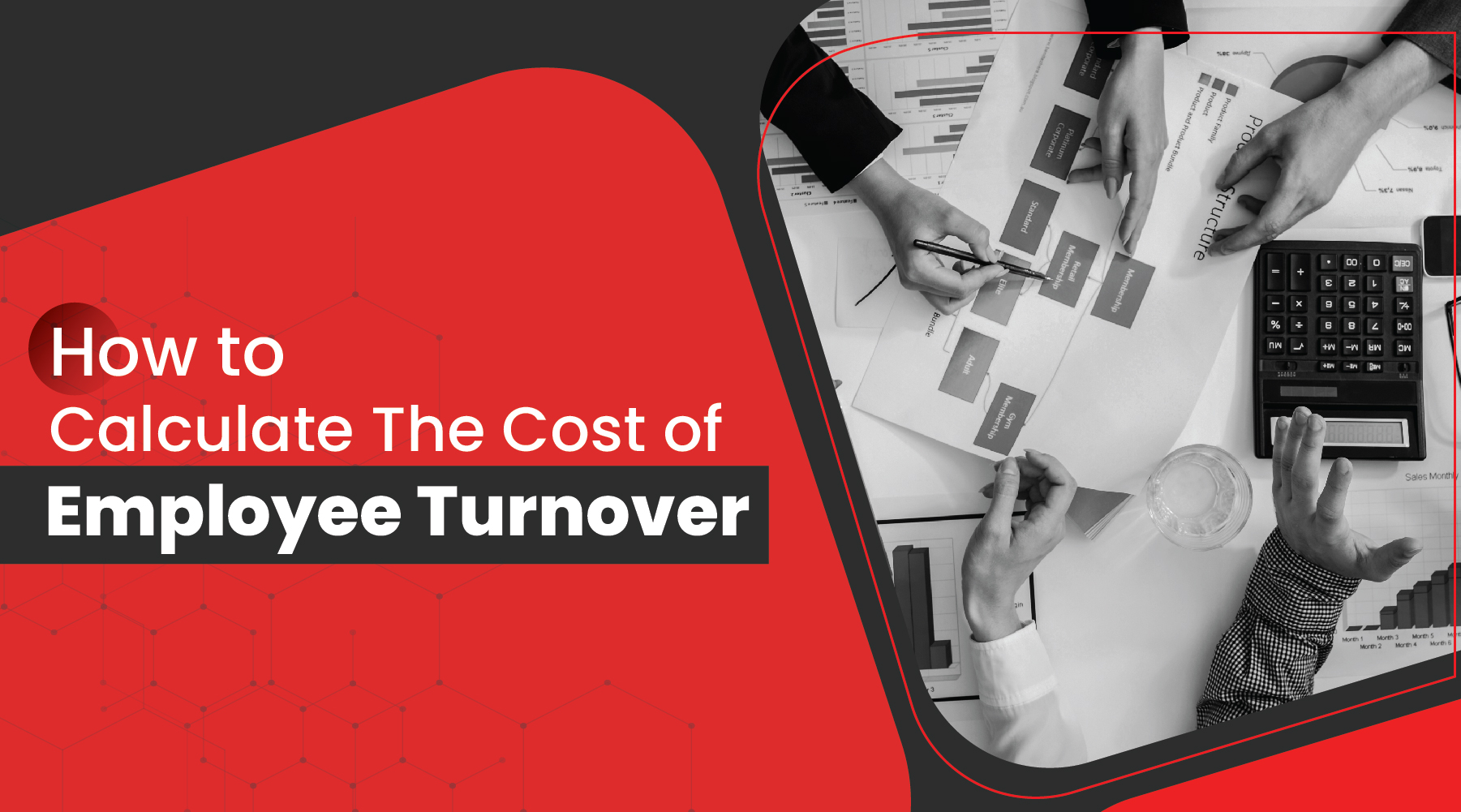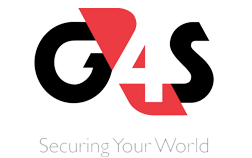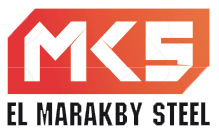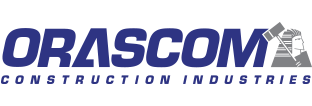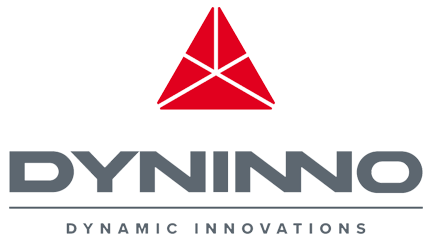When an employee asks to leave, should you, as an employer, just let them leave? Or should you ask them to stay and counter-offer the salary they received from another company?
Employee turnover is one of the biggest challenges for businesses of any size and industry.
While employees quit for many reasons, it’s important to identify those reasons and work on retaining employees instead of letting them leave.
What many employers today don’t realize is the cost of employee turnover. That is the amount of money they’re losing when employees leave, especially good and once-loyal employees.
These employers don’t calculate the costs they’re incurring because of these employees who are leaving. Accordingly, they remain unaware of their losses.
Many businesses assume that if a high-salaried employee leaves, they can ‘replace’ them with a low-salaried one. Thinking they have ‘saved’ money.
The truth is, it’s not such an easy equation. To see how much you’re making or rather losing, you need to calculate the cost of employee turnover.
In this article, we’ll highlight the problems with employee turnover and show you how to calculate two turnover-related metrics. Discover how to calculate the rate of turnover and how to calculate the cost of employee turnover in your organization.
Why do employees leave?

why do employees leave?
Answering the question of why employees can be explained in a full-length book, but we’ll try to be brief.
The top reasons affecting employee turnover include:
- Not feeling appreciated
- Toxic work environments
- Lack of career development
- Absence of a company structure where employees can get promoted
- Low pay or outdated salary offerings
- Bad management
- Micro management
- Lack of motivation
- Hiring mistakes made by employers
Why employee turnover matters
Today’s job market is competitive. Globally. There are new jobs emerging requiring both soft and hard skills. Meanwhile, many employees are looking for more part-time and work-from-home opportunities, which many employers don’t seem to offer.
In other words, there’s a gap between employers and what employees are offering.
As a business, you need to see why employees are leaving your organization. Here are a few questions to ask:
- Did they get a better offer elsewhere?
- Are they worth more than what you’re paying them?
- Do you have a salary structure that’s up-to-date and ensures employees get what they’re worth?
- Do you offer compensation and benefits? Or is it just a salary and social insurance?
- Do you have an attractive work environment? Or is it a toxic one that prompts people to leave?
It’s important that you ask current employees and those who left these questions instead of answering them yourself.
It’s easy to say that your office and company culture is a proactive and supportive one, whereas employees leave because they feel it’s toxic.
So, why is employee turnover a bad thing?
Here are a few reasons:
- Hurts morale
- Affects team or department productivity
- Increases recruitment costs
- A decline in productivity may reduce sales
- Creates a sense of instability, prompting more people to leave
- Time needed to train new employees
- Longer time needed to find suitable candidates and hire them, especially for senior and managerial roles
How to calculate the rate of employee turnover
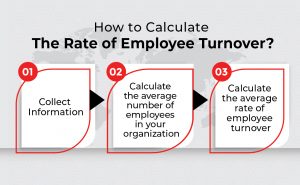
how to calculate the rate of employee turnover?
Before you begin the steps of calculating the cost of staff turnover in your company, you must first
- Calculate the average rate of turnover.
- Decide on the period you’ll be calculating the rate of turnover for.
It’s best if you calculate both the rate of turnover and the cost of turnover on an annual basis and review the cost on a quarterly basis.
It’s worth mentioning that the cost of turnover is sometimes referred to as the cost of attrition.
Step 1: Collect information
To calculate staff turnover, you need to gather three pieces of information. These are:
- The number of employees at the start of a period, we recommend a year.
- The number of employees at the end of that same period.
- The number of employees who left during that period or year.
Step 2: Calculate the average number of employees in your organization
Once you’ve gathered the above numbers, it’s time to calculate the average number of employees in your company.
To get this number, you’ll need to add the first elements from the information you gathered. This means you need to add the number of employees at the start of the period (year) to the number of employees you had at the end of the period (year). Then you should divide the resulting number by 2.
Average no. of employees = number of employees at the start of the year + number of employees at year end = X / 2 =
Let’s say you started the year with 50 employees. During the year, 15 employees left, while others were hired. You ended the year with 70 employees.
In this case, the calculation would look like this:
50+70 = 120 / 2 = 60
You had an average number of 60 employees this year.
Step 3: Calculate the average rate of employee turnover
Now it’s time to calculate the rate of turnover in your company.
In this step, you’ll need to divide the number of employees who left your company during the period (year) by the average number of employees you got from step 2. Then multiply the result by 100 to get a percentage or rate.
Here’s what the cost of employee turnover formula looks like:
Annual employee turnover cost = [(number of employees who left/ average number of employees) x 100 = %
Using the same numbers from step 2, the equation would look like this:
15/60 = 25%
How to calculate cost of employee turnover: Steps and metrics
Whether you realize it or not, when employees leave, you lose money. Even if you get a new hire for a lower salary than the one who left, the cost isn’t calculated based on salary alone.
As you’ll see there are more factors that contribute to the cost of attrition other than the salary and benefits the employee receives.
Before we dive into costs, we must stress the following:
The cost of employee turnover differs based on industry, role, location (city or country), and seniority of the role.
Costs are also affected by whether the role is a revenue-generating one or not.
For example, employee turnover costs for oil-and-gas engineers in Egypt differ from those in the UAE or Saudi Arabia.
Many believe that they can simply multiply the gross salary of a certain position by 12 to get the annual cost.
However, there’s much more to the cost of employee turnover than just how much the job pays.
According to the Predicative Index, you need five metrics or pieces of information to calculate this figure. You need:
1) Benchmark employee cost
This metric indicates the amount of money your company is losing each day the vacancy is not filled.
2) Coverage cost to fill a vacant position
This metric indicates the cost your company incurs till the vacancy is filled. It includes costs incurred if other team members take on extra work and get paid overtime to cover the vacancy till a new hire joins.
The coverage cost also takes into account the lost productivity by other team members whose workload has increased.
To calculate the coverage cost, you’ll need to multiply the “number of days the position remains open” by the “daily rate provided in the benchmark costs.”
3) Cost to fill the job vacancy
This includes the cost of all other parties involved in the recruitment process. The cost to fill a job vacancy includes:
- Recruitment cost or talent acquisition cost
- Cost of advertising
- Screening
- Selection
- Time taken to conduct and review assessments or testing
- Background checks
- The interview process
- Additional services such as the cost of designing the post on social media…etc.
4) On-boarding and orientation costs
These costs include work-related supplies such as a new office, laptop, mobile phone, business line, bank account, and welcome swag or package. On-boarding costs may also include training sessions or workshops.
5) Productivity cost
The cost of productivity, also known as productivity ramp up cost, is the time it takes a new employee to reach the value or equivalent provided by the employee who left.
It takes a new employee at least three to four months to reach 50% to 100% of the previous employee’s average production. Assuming this person is of the same level of experience and background as the person who left.
Usually, the recruitment process takes at least one month to find a new hire. This new hire will not be able to reach the productivity level of the former employee in the first two months. They may be able to reach 50% by the second half of the second month or towards the third month.
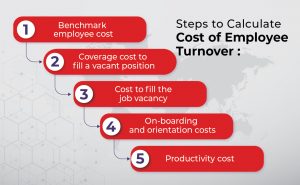
steps to calculate cost of employee turnover
How to calculate the cost of employee turnover: formula
Now that we’ve covered what’s involved in calculating the cost of staff turnover, let’s look at the formula.
To calculate your company’s employee turnover cost, you’ll need to add the coverage cost of your vacant position along with the cost of on-boarding & orientation and the cost of filling the vacancy and the productivity ramp up cost. Then you’ll need to multiply the result by the number of employees who left in a year and multiply the result by 12 to get the annual cost of turnover.
Cost of employee turnover = on-boarding and orientation costs + coverage cost + productivity ramp up cost + cost to fill vacancy x number of employees who left that position in a year x 12 = annual rate
Wrap up
As you can see, employee turnover can be quite costly for a company. Smaller companies often think an employee is replaceable and that it would be easy to find someone else.
However, it’s usually not the case. In the above examples, we assume that the average hiring time takes three to four months to complete.
Some senior roles require employees to give their employer a two-month notice, resulting in a longer period before they’re hired.
For other roles, like software development-related roles, the hiring process can take 2 to 3 months to complete.
Do you need help calculating the cost of employee turnover in your company? Do you want to diagnose problems and create an HR strategy and a GAP analysis to reduce employee turnover?
Then, reach out to Tawzef. We’ll help you set up your pay structure, uncover why employees are living and provide you with support for retaining current and new employees and reducing turnover.






